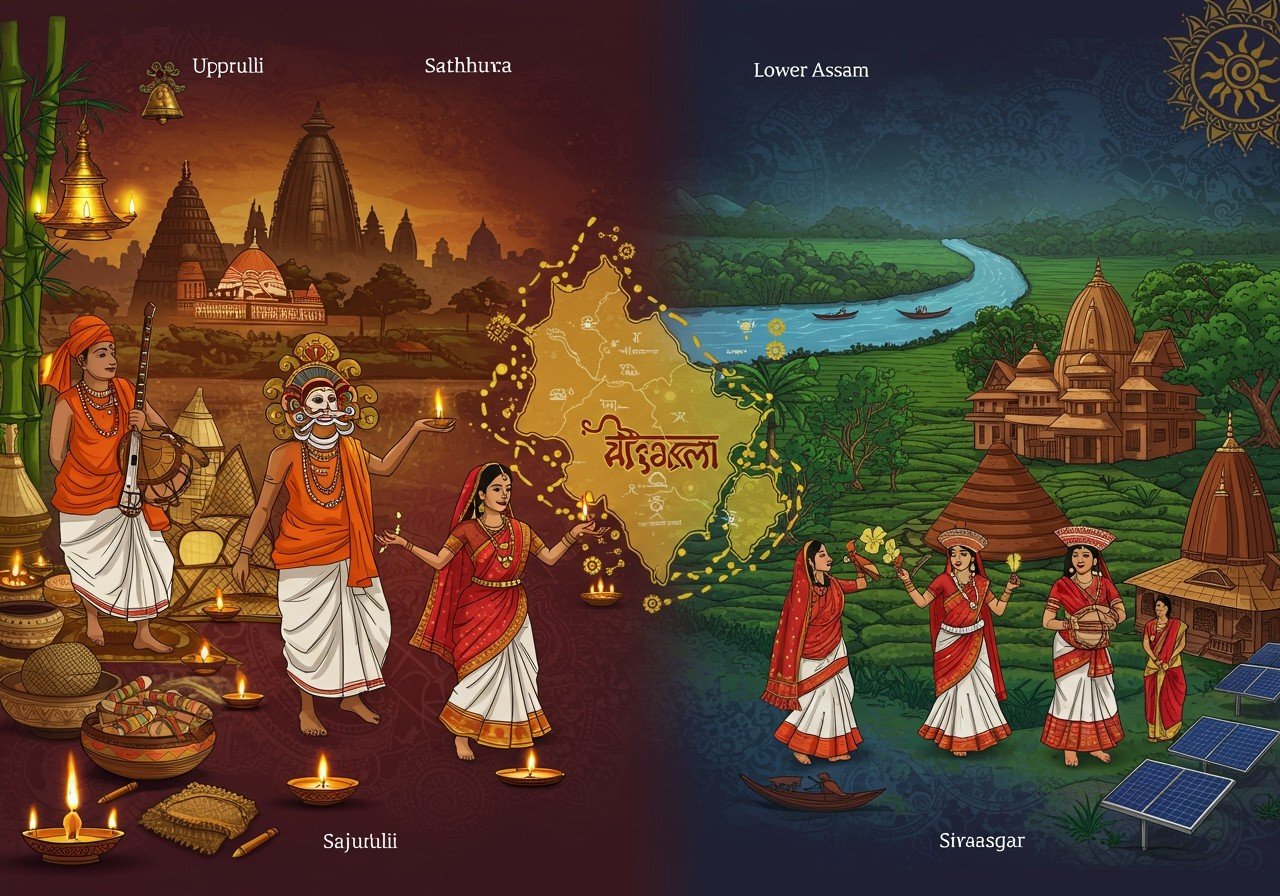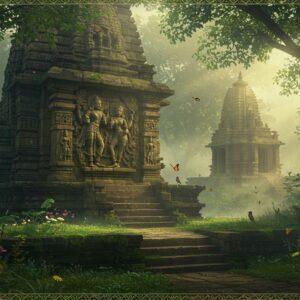
Assam, a jewel in India’s northeast, boasts a rich heritage and diverse cultural landscape. This exploration delves into the unique characteristics of Upper and Lower Assam, highlighting the nuances in their traditions, languages, and lifestyles. Understanding these distinctions allows us to appreciate the vibrant mosaic that makes up Assamese culture.
A Journey Through Time: Historical Context
Upper Assam’s history is deeply intertwined with the Ahom dynasty, which reigned for over six centuries, leaving an indelible mark on the region’s cultural fabric. Numerous historical sites stand as testaments to this glorious era. Discover more about Assam’s spiritual heart. Lower Assam, on the other hand, flourished under the Kamarupa kingdom. The colonial period brought significant transformations to Lower Assam, with the introduction of tea plantations and railways, shaping its economic trajectory. These historical trade routes between Upper and Lower Assam further contributed to their economic development.
Cultural Nuances: A Celebration of Diversity
Cultural practices blossom differently across Upper and Lower Assam. In Upper Assam, the Assamese language and its various dialects resonate, often considered the “standard” accent. Lower Assam reveals a noticeable Bengali influence, adding another layer to the linguistic tapestry. Festivals, too, take on unique hues. Rongali Bihu, a joyous harvest festival, is celebrated with immense fervor in Upper Assam, while Bhogali Bihu holds a special place in Lower Assam’s heart. Even the beloved Raas festival showcases regional variations. In Upper Assam, Raas unfolds through captivating human enactments, adhering to Vaisnavite traditions, whereas in Lower Assam, it is observed through the reverence of idols. Dive deeper into the rituals and practices of Assam.
Economic Landscapes: From Tea Gardens to Fertile Fields
The economic heartbeats of Upper and Lower Assam pulse with distinct rhythms. Upper Assam thrives on the lush tea gardens that carpet its landscape, a vital source of livelihood and economic prosperity. Lower Assam, in contrast, draws strength from agriculture, with rice cultivation and fisheries forming the bedrock of its economy. Government initiatives also paint different strokes on the canvas of development – the oil industry’s expansion in Upper Assam and flood management projects in Lower Assam. Looking for high-quality puja samagri? Visit Poojn.in to explore our collection.
Geographical Wonders: Rivers, Plains, and Majestic Wildlife
Geography carves its own narrative, distinguishing Upper and Lower Assam. The mighty Brahmaputra River, a lifeline for the state, shapes both regions, sculpting their landscapes and ecosystems. Upper Assam is adorned with verdant tea gardens and undulating hills, a picturesque panorama. Lower Assam unfolds with fertile plains and vital wetlands, nurturing a rich biodiversity. National parks, sanctuaries of nature’s wonders, add another dimension. Kaziranga National Park in Upper Assam shelters the iconic one-horned rhinoceros, while Manas National Park in Lower Assam safeguards a treasure trove of flora and fauna. Embark on a spiritual journey through Assam’s sacred sites.
Social Fabric: A Tapestry of Communities and Beliefs
Upper and Lower Assam display unique demographic patterns and social characteristics. Upper Assam is predominantly Hindu, with indigenous tribal communities enriching the cultural tapestry. Lower Assam, with a higher percentage of Bengali speakers, also embraces a substantial Muslim population. These demographics influence social customs and traditions, creating a vibrant mix of cultures. Educational opportunities and literacy rates also reflect regional disparities. Pooja essentials for every occasion are available at Poojn.in.
Looking Ahead: Assam in 2025 and Beyond
As we gaze towards 2025 and beyond, both Upper and Lower Assam hold immense potential for progress. Tourism, a beacon of economic opportunity, beckons, promising to showcase the regions’ natural beauty and cultural heritage. Technological advancements offer avenues for innovation and development. Government policies strive to bridge the developmental gaps between Upper and Lower Assam, fostering balanced growth and prosperity. Cultural exchange emerges as a powerful tool to preserve Assam’s rich traditions while fostering unity and understanding. We offer a wide selection of Panchguri and other essential puja items.
Frequently Asked Questions: Understanding the Nuances
What distinguishes Upper Assam from Lower Assam? Upper Assam is characterized by its sprawling tea gardens and oil fields, while Lower Assam captivates with its vibrant cultural heritage and historical landmarks. Geography, culture, and economic activities weave distinct narratives for each region.
Do the languages spoken in Upper and Lower Assam differ? While Assamese serves as the lingua franca in both regions, dialects and accents vary, adding to the linguistic richness. Upper Assam’s linguistic landscape is influenced by its unique historical and cultural interactions.
Which region boasts more historical sites? Lower Assam, with its ancient temples, monuments, and remnants of kingdoms past, holds a treasure trove of historical sites. Upper Assam, while rich in history, is more renowned for its natural beauty and tea estates.
Are there variations in the festivals celebrated? Both regions partake in the major Assamese festivals, particularly Bihu, but the local festivities and their observance may differ. Lower Assam boasts unique festivals that mirror its specific cultural heritage. Find everything you need for your puja on Poojn.in.
How do the economies of Upper and Lower Assam compare? Upper Assam’s economy is driven by the tea and oil industries, significant contributors to its growth. Lower Assam, on the other hand, leans towards agriculture and tourism, with its cultural heritage playing a pivotal role.
Which part of Assam is more developed? Development is a nuanced picture, varying across areas. Upper Assam has experienced industrial growth, propelled by the tea and oil sectors. Lower Assam has witnessed progress in tourism and infrastructure development.
Is there a difference in climate? Both regions share a sub-tropical climate, but subtle variations exist. Upper Assam, due to its geographical features, may experience slightly cooler temperatures.
Does the wildlife differ between the two regions? Assam, a biodiversity hotspot, offers a rich tapestry of wildlife in both regions. However, the specific species and their habitats vary. Upper Assam’s tea gardens and forests nurture a unique ecosystem, while Lower Assam’s riverine and forest environments support diverse flora and fauna.
Poojn.in: Your Companion in Preserving Assamese Traditions
At Poojn.in, we understand the profound significance of rituals and traditions in Assamese culture. We offer a curated selection of authentic puja items, catering to the specific needs of both Upper and Lower Assam. Whether you seek traditional Kusha Pat (কুশ পত), pure copper utensils, intricately crafted bell metal items, region-specific puja thalis, or customary ritual items, our online store provides a convenient and reliable platform to honor your traditions.
We are committed to delivering quality and authenticity. All our products undergo stringent quality checks and are packaged with utmost care to preserve their sanctity. With doorstep delivery across Assam, including all districts in both Upper and Lower Assam, we ensure that you receive your chosen items in perfect condition. Explore our extensive range of bati, Arjun Chal, and Ashoka Chal at Poojn.in.
Embracing Assam’s Rich Tapestry
Upper and Lower Assam, with their distinct histories, vibrant cultures, and unique landscapes, showcase the remarkable diversity of this beautiful state. As we move forward, the potential for growth, development, and cultural exchange is immense. By embracing the differences and celebrating the shared heritage, we can cherish Assam’s unity in diversity, a testament to its vibrant spirit and enduring traditions. Experience the spiritual heart of Assam with us.


